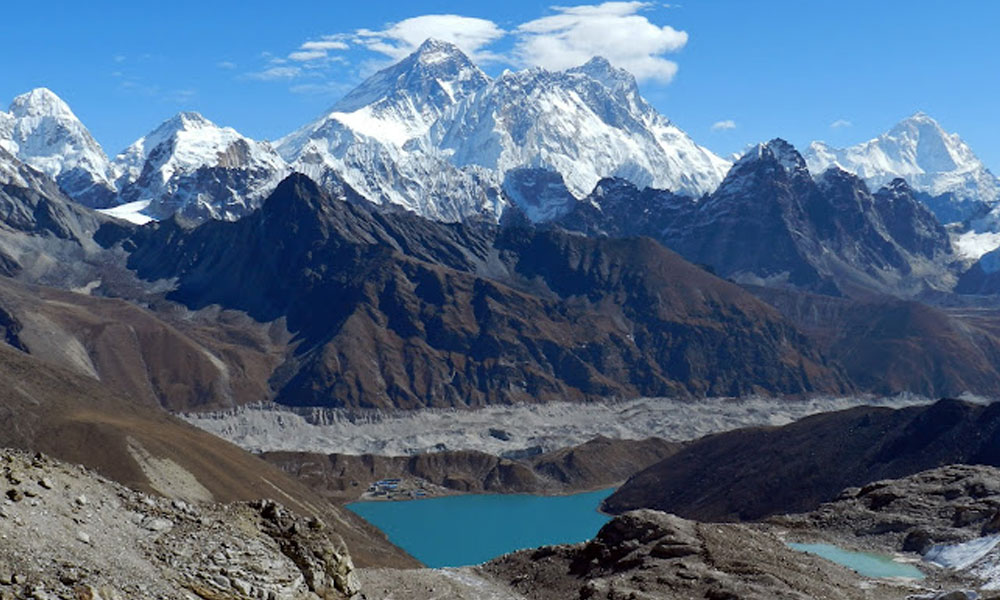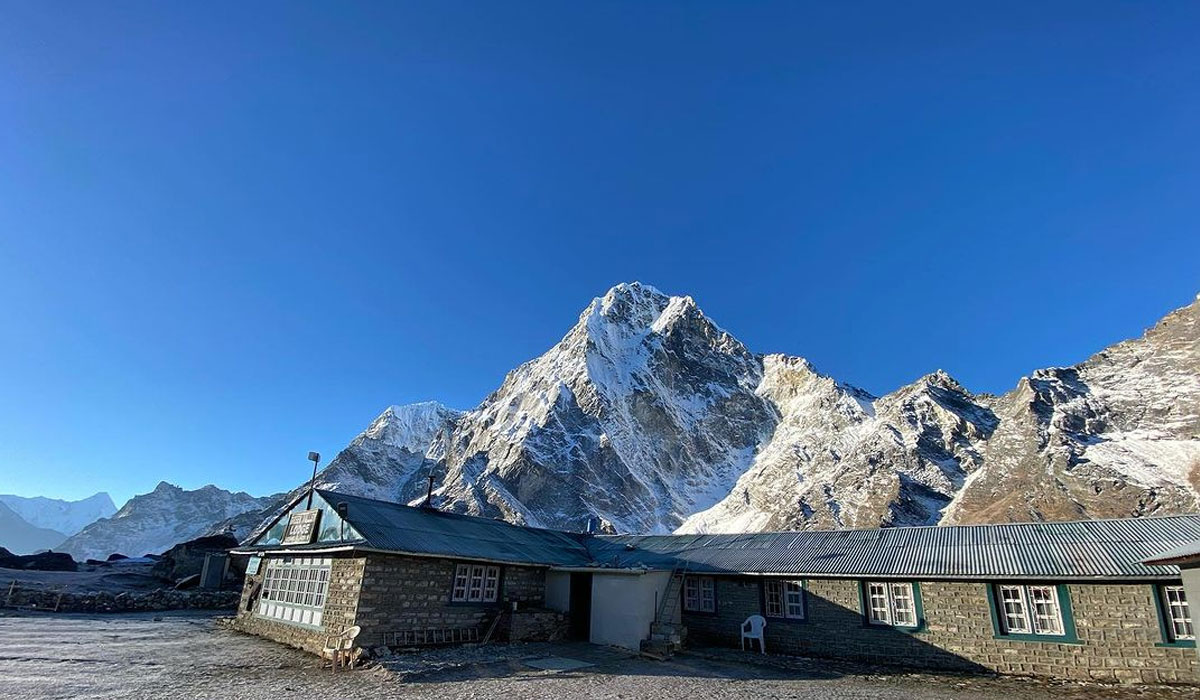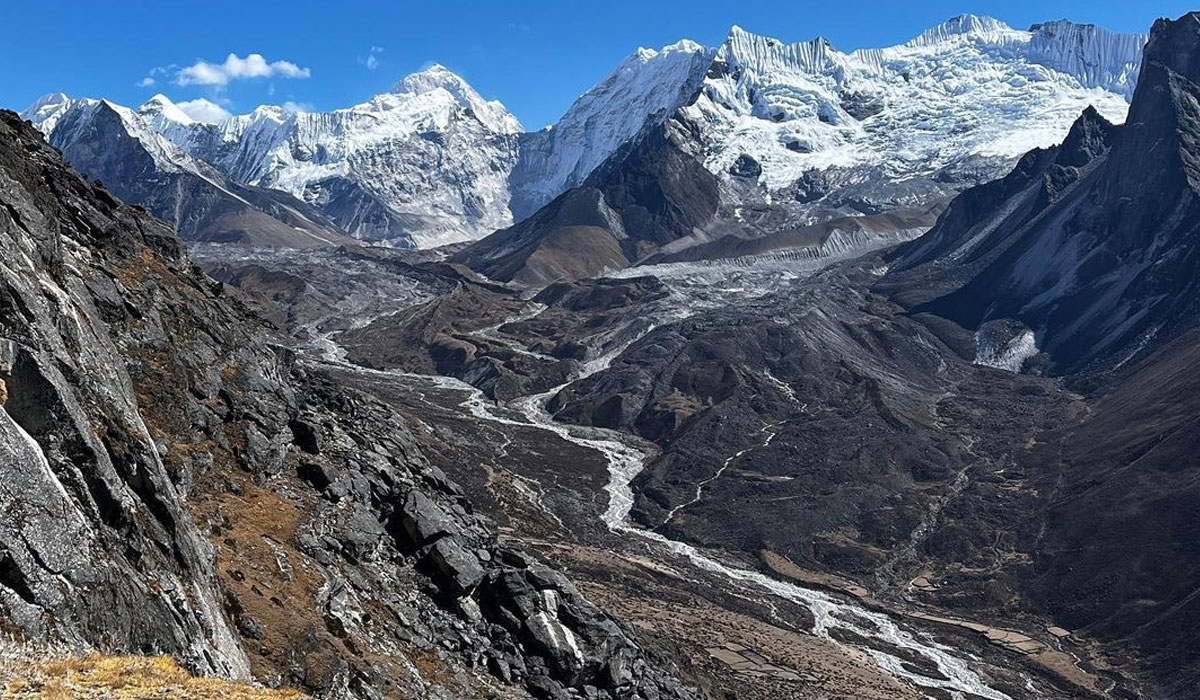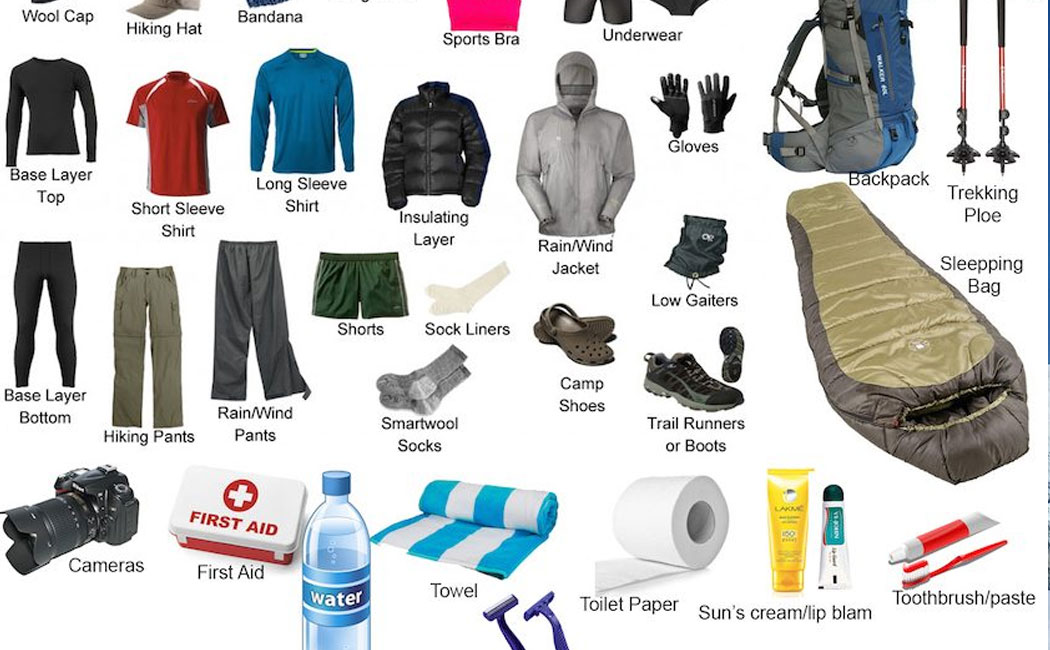
The Three Passes trek is a challenging and adventurous journey in the Everest region. The trek involves the crossing of three major high-altitude passes: Kongma La (5,540 meters/18,176 feet), Cho La (5,420 meters/17,782 feet), and Renjo La (5,345 meters, 17,536 feet).When discussing the Three Passes Trek Difficulty, these high altitudes and steep ascents make it one of the most demanding yet rewarding treks in the Himalayas. The Three Passes trekking route, one of the best in the Himalayas, starts and ends in Lukla. With the mighty Mount Everest ruling over the Everest region, several other mountains stand majestically, manifesting spectacular beauty. Throughout the journey, the mesmerizing views of numerous hidden peaks like Sundar Peak in Thame, Nangkartshang Peak in Lungden, Ngozumpa Tse Peak in Gokyo, etc, captivate the Three Passes journey.
The trail passes through the Sagarmatha National Park, a sanctuary of diverse ecosystem. The trek takes you further to the charming Sherpa villages, ancient monasteries, and varying high-altitude landscapes. Three Passes Trek offers breathtaking views of 8,000 meters class majestic mountain peaks like Everest (8,848 meters), Makalu (8,463 meters), Lhotse (8,516 meters), and Cho Oyu (8,201 meters). Similarly, the captivative panoramic views of other snow-covered Himalayas are seen from each of these passes. Traversing the trails, you get to explore the remote Everest region alongside the spectacular mountain panoramas and strikingly enchanting landscapes. So, the Three Passes Trek is undeniably suitable for adventure enthusiasts and naturalist trekkers.
However, the Three Passes Trek Difficulty is quite significant, as it takes you to the three main challenging passes of the high-altitude Himalayan region. The crossing of these higher altitudes demands prior experience in high-altitude trekking and thorough preparation. Reasonable strength and stamina with endurance capacity are required to withstand and face the challenges of the Three Passes journey. The trek follows adventurous trails over rocky mountains and glaciers. Most of the Khumbu region is covered by this trek, traversing the challenging mountainous routes. The loose rock sections and snowy narrow passes are difficult to navigate. The trek also involves walking into thin ice layers and melting glaciers. The few glaciers on the trekking route are slippery and tough to pass through. Although the Three Passes Trek in the Himalayas is difficult, it is a rewarding adventure for experienced trekkers.
Highlights of the Three Passes Trek

- A scenic flight from Kathmandu to Lukla with breathtaking aerial views of the stunning Himalayas.
- Explore the famous Sherpa town, Namche Bazaar, and soak in its vibrant atmosphere.
- You can learn and understand the traditional Sherpa settlements of lower Thame Valley and Marlung village, including the typical lifestyle and culture of the people along the way.
- You will also get to experience the ancient Tibetan traditions by trekking through several rural villages.
- Visit Tengboche Monastery on a hill with an unobstructed view of Mount Everest.
- Trek to sacred Gokyo Lakes alongside the outstanding mountain views.
- Crossing suspension bridges over the enchanting river flows that are adorned with colored prayer flags.
- Traversing through dense rhododendron forests, picturesque villages, astounding lakes, and lush valleys with awe-inspiring mountain scenery.
- Encountering the diverse Himalayan wild species and vegetation.
- Navigate the Khumbu Glacier (5,364 meters/17,598 feet), the largest glacier in the World at the base of Mount Everest.
- Panoramic views of sunrise and sunset from the vantage point of Kala Patthar.
Long Distance and Duration

The Three Passes Trek is a long-distance journey. The duration of the trek varies depending on the route, acclimatization days, and the speed of each trekker. Generally, the trek is completed in around 18 to 20 days, after covering around 180-200 kilometers/122-124 miles of long distance. Daily trekking hours can differ, but approximately, you have to walk for about 8 to 10 kilometers, i.e., 5 to 7 miles each day. Several hours of trekking to cover considerable distances daily and crossing consecutive challenging high mountain passes is draining.
The trek involves lots of ascends and descends in steep terrains. Trekking through the inclined routes is highly strenuous. It is essential to be physically fit and mentally prepared for the sustained efforts required during the trekking journey. Though the trek is undoubtedly adventurous, the long journey is exhausting. The rough trails of uneven surfaces come with new challenges each day. However, the mountainous trails in the rugged landscapes provide you with the feeling of wilderness adventure.
A strong mental preparedness accompanied by the proper physical strength counts in overcoming the Three Passes Trek difficulties. Prepare to adapt yourself to the rural lifestyle as you will be trekking in remote areas with no modern facilities. Likewise, the crossings of three challenging passes require overcoming fear of heights and exposure. So, trek with a positive mindset to triumph over the daring Three Passes trekking journey.
High Altitude

The Three Passes Trek journey starts from Kathmandu (1,400 meters/4,594 feet) with a flight to reach Lukla, the gateway of the Everest region. Lukla (2,860 meters/9,383 feet) is a small mountain town in the Khumbu region. The trek initiates from Lukla and heads towards Namche Bazaar (3,440 meters/11,286 feet), Tengboche (3,867 meters/12,687 feet), Dingboche (4,365 meters/14,321) feet, Chukung (4,670 meters/15,322) feet and finally crosses the initial high pass, Kongma La (5,540 meters/18, 176 feet). Likewise, the other two high passes, Renjo La (5345 meters, 17,536 feet) and Cho La (5,420 meters/17,782 feet) crossing takes you above the altitude of 5,000 meters. With all three major passes exceeding 5,300 meters, the trek is significantly challenging.
Similarly, the Everest Base Camp (5,365 meters/17,598 feet) and the highest point of the trek, Kala Patthar (5,644 m/18,519 feet), have high altitudes with low oxygen levels. So, there is a very high chance of altitude sickness during this trek. You need to be prepared for the challenges of high altitude environment, including weather and temperature fluctuations. These challenging passes have steep ascents and descents sections and navigation through the rocky and icy trails.
The Kathmandu to Lukla flight reaches you at 2,860 meters from 1,400 meters within just 25 to 30 minutes. You will experience a sudden elevation gain of 1,460 in such a short time, which may pose several health issues. Likewise, throughout the journey, you will gain 500 meters to 700 meters of elevation within 6 to 8 hours of trek daily. Trekkers with no previous experience in high-altitude adventure can find the trek strenuous and challenging to reach certain heights at each day's destination.
Not only ascend, but the trek also follows significant descents. For example, descending from Kalapatthar to Dzongla (4,787 meters) and Renjo La Pass to Lungden (4,385 meters) involves an elevation loss of around 700 meters to 1,000 meters, respectively. If you are not used to the altitude change, your body may not adapt to the shifting altitudes properly. Therefore, proper acclimation for adequate days is crucial to keep the body fit and adjustable to the alpine altitudes and environment.
Altitude Sickness

The risk of altitude sickness rises once you reach Lukla. Lukla is at a height of 2,860 meters, which already exceeds the limit for altitude sickness prevalence. More higher you go, the oxygen level decreases even more. At the altitudes of Everest Base Camp, Kala Patthar, and three high passes, the level of oxygen is only 50% of that at sea level.
Altitude sickness is a major concern as the trek involves substantial elevation gain while ascending to the three major passes, Kongma La, Cho La, and Renjo La, each exceeding 5,300 meters. The symptoms of altitude sickness, like headache, nausea, dizziness, fatigue, insomnia, etc, start to occur. It may take severe forms such as High Altitude Pulmonary Edema (HAPE) and High Altitude Cerebral Edema (HACE).
Descending to the lower elevations is the primary step to treat the altitude symptoms. The risk of altitude sickness differs for each individual when some may be more susceptible, and others may not. Dehydration can boost the risk, as air at higher altitudes is drier, and you may not feel thirsty, resulting in inadequate fluid intake. However, staying well hydrated and maintaining a slow pace of elevation gain is helpful for mitigating altitude sickness. With adequate acclimatization days, acclimatize properly to adjust to the rising elevation and do not ascent until the body gets ready for further adventure.
Remoteness

The Everest region is remote with no luxury when you may be used to the luxurious lifestyle. You can miss your warm bed and hot shower during the journey. The classic exploration through the foothills of the breathtaking Himalayas is not a small deal. Also, do not fail to realize that the Three Passes Trek is a remote exploration with no comfort of modernity.
The trekking journey occurs in the rustic mountainous region, with no services and amenities like a lavish vacation destination. The region is back at the infrastructural and technological advancement due to the lack of a proper transportation system. The medical services are also limited, with few in the lower region of the trekking trails. Health centers are not well equipped with adequate medicines, the region also lacks other basi services like electricity, internet, telecommunication services, and many more. The facilities at higher altitude regions are more scarce. So be prepared for the inconveniences you face on the trekking trail of the Three Passes.
In the case of emergencies, the evacuation can be challenging due to the remote mountainous terrains. So, it is better to have the travel insurance with evacuation coverage. Do not expect accommodations with modern amenities as teahouse facilities become more basic with low availability at high altitudes. Be self-sufficient, carrying essential items to avoid any discomfort. Remoteness, on the other hand, contributes to a serene and solitary trekking experience. Feel the Himalayan tranquility with an immersive connection to nature while on a Three Pass Trek.
Seasonal Difficulty and Climatic Variations

The high-altitude weather is unpredictable and changes rapidly. Similarly, the temperature also fluctuates a lot. The daytime and nighttime temperatures vary heavily in the high-altitude regions. The rising altitudes or daily temperature differences can cause sudden climatic changes. The rapid shifts in atmospheric conditions may result in cold temperatures with possible snowfall. Weather-related delays may occur during the journey. So, you should be prepared for the varying weather conditions and temperatures while trekking at alpine elevations.
The weather in spring (March, April, and May) and autumn (September, October, and November) is usually stable, with excellent visibility in clear skies and moderate temperatures. So, these are considered the best seasons to do the Three Passes Trek. The daytime temperature during these seasons ranges from 10 to 20 degrees Celcius. Autumn features a dry climate with minimum possibility of snow and rain. Spring comes with full blooming, creating mesmerizing mountainous scenery. April in spring is the ideal month for Three Passes Trek, with neither unbearably hot nor bitterly cold temperatures.
The monsoon season (June, July, and August), starting in late June and lasting until the end of September, comes with heavy rainfall, which is unfavorable for outdoor activities. Clouds, mist, and fog can obstruct the Himalaya's views. Precipitation is common, resulting the rainfall in lower elevations and snowfall in higher elevations. Likewise, the temperature in summer/monsoon can range from 15 to 25 degrees Celsius. The scorching temperatures and muddy trails during this time are difficult to deal with. Consider packing rain gear and seasonal clothing to cope with the varying climatic conditions.
Winter (December, January, and February) brings extremely colder temperatures with heavy snowfall. The accumulation of snow on trails creates difficulty in trekking and crossing the high mountain passes. The temperature ranges from 5 to 15 degrees Celcius upto the moderate elevations and drops below the freezing scale at higher altitudes. The possible wind chill can trouble the pass crossings. Regardless of the season, the temperature in High Pass Base Camps or the high passes can drop to -10 to -12 degrees Celcius.
Note: To suggest that the best time to trek is from March to May and September to November. It is because the weather is more stable, and you are unlikely to encounter heavy rain or snow.
Dealing with Three Passes Trek Difficulty

There is a high chance of being affected by altitude sickness while doing the Three Passes Trek. Likewise, you can lose track of the trek while crossing the challenging high mountain passes due to varying and unpredictable weather conditions. So, you need to follow effective safety precautions to remain safe and successfully complete this daring and adventurous trek. Here are some ways to deal with the difficulties of the Three Passes Trek.
Acclimatization
- Take adequate days to acclimatize well and adjust the body to the rising elevations.
- Consider covering only the appropriate distance and elevation during each day of the trekking journey.
- Be wary of the symptoms of altitude sickness, and act listening to your body.
- Do not push your limits to attempt the trek forcefully. If any difficulty arises, be open to sharing with your guides.
Proper Diet and Hydration
- Drink plenty of water to keep the body nourishing and hydrated. Good hydration helps to minimize the risk of altitude sickness.
- Be conscious of health, drinking hot or purified water.
- Eat nutritious food rich in vitamins and proteins. Maintain a proper diet to stay healthy, avoiding the possible illness.
Weather Consideration
- Be cautious of uncertain weather changes and always keep an eye out for the weather forecast before embarking on an everyday journey.
- Carry the right trekking gear and an appropriate layer of clothing that suits the trek conditions, weather, and temperature.
Pack the Right Gear

It is important to prepare your backpack before leaving for the trekking journey. Well-packed items aid travel and enable quick access in need. All the necessary items must be packed lightly for an easy and comfortable carry. The Three Passes Trek is lengthy, covering diverse sections of the Himalayas. It involves multiple days of high-altitude trekking in the harsh mountainous terrains and weather conditions. Packing the right things eases the activities and provides an enhanced trekking experience. So, the following items of appropriate gear are recommended to carry.
- Hiking boot (with ankle support recommended)
- Trekking pole
- Headlamp (carry extra batteries)
- Sleeping bag (advisable to have one)
- Down Jacket
- Thermal sweaters
- Comfortable, flexible, and dry hiking pants
- A backpack (Lightweight waterproof that evenly distributes the weight)
- Hiking socks (thick to regulate temperature and prevent the feet from getting sweaty)
- First aid kit
- Additionally, pack a sun hat, head cover, UV protective sunglass, lip balm, high SPF sun cream, thick and thin gloves, water bottles, camera, etc.
You may also like:
- Jiri to Everest Base Camp Trekking
- Everest Panorama Trekking
- Everest Base Camp Gokyo Lakes Trek
- Everest Base Camp Trek
Note: It is important to check your gear before packing. For example, test for size and adjustment of your trekking boots for mountain trails; bigger is better.
Training and Preparation

- Prepare yourself with prior training, engaging in regular light exercise and cardiovascular and endurance-building sessions.
- Swimming, yoga, cycling, dancing, push-ups, deadlifts, aerobics, running, etc., help to build strength and also assist easy breathing in high altitude journeys.
- Practice training with the backpacks to be accustomed to trekking with moderate weight.
- Avoid consuming alcoholic drinks, cigarettes, etc, that cause health hazards and trouble the high-altitude adventurous journey.
- Carry a first aid box for instant application in case of accidents/injuries and general medications like paracetamol and diamox tablets.
- Review gear and equipment thoroughly before attempting the challenging ascends.

